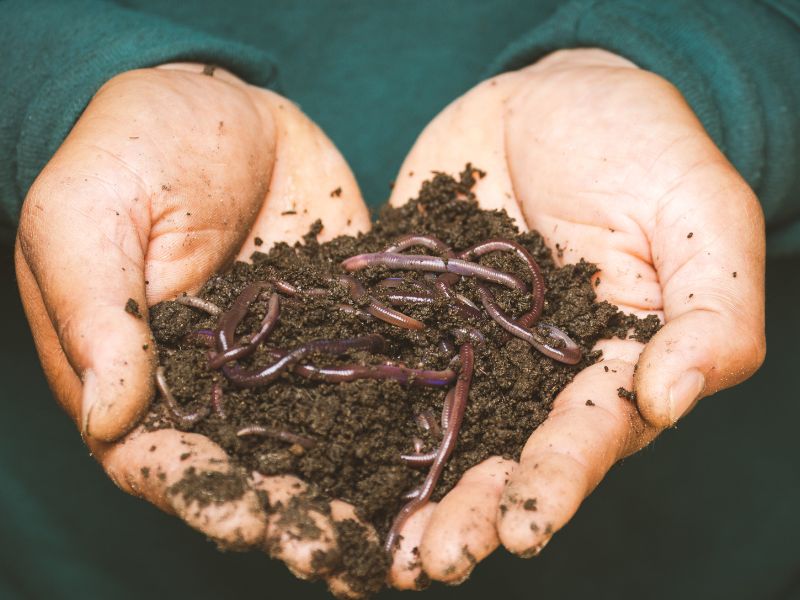Discovering the Systems of Red Wiggler Composting: A Comprehensive Guide to the Refine and Its Favorable Influence On Lasting Gardening Practices
The elaborate mechanisms of red wiggler composting, making use of the one-of-a-kind physiology of Eisenia fetida, offer an engaging method for enhancing lasting gardening methods. This process not only changes organic waste right into nutrient-dense vermicompost but likewise fosters a much healthier soil ecosystem via enhanced aeration and microbial activity. As city horticulture gains grip, understanding the nuances of this composting approach becomes progressively appropriate. However, the trip into its myriad advantages and best methods is simply starting, motivating a better assessment of exactly how this technique can improve our gardening strategies.
Comprehending Red Wigglers
Red wigglers, scientifically called Eisenia fetida, are a varieties of earthworm highly related to for their performance in composting organic waste. These worms prosper in nutrient-rich environments, particularly in decomposing raw material, making them ideal for vermicomposting systems - Red Wiggler Composting. Defined by their reddish-brown coloration and fractional bodies, red wigglers are smaller sized than common earthworms, generally gauging between three to 4 inches in length
Their unique physiological characteristics enhance their composting abilities; for circumstances, they have a high reproductive price, permitting populations to increase rapidly under ideal conditions. Red wigglers consume organic material, simplifying via their gastrointestinal systems, which results in nutrient-rich castings that serve as an excellent organic fertilizer. Their starved hunger allows them to process huge quantities of food waste efficiently, significantly decreasing landfill payments.
Along with their composting expertise, red wigglers play an important duty in soil wellness. Red Wiggler Composting. They aerate the dirt and promote the disintegration of raw material, additional enriching the dirt environment. Recognizing the features and ecological advantages of red wigglers is important for anybody seeking to apply sustainable horticulture methods through reliable composting methods
The Composting Process
The composting process involves breaking down organic products into nutrient-rich garden compost, a task that red wigglers stand out at because of their specialized digestive system systems. These worms consume food scraps, backyard waste, and other organic matter, transforming them into valuable garden compost via a collection of chemical and biological procedures.
At first, the raw material is mixed with bedding products such as shredded paper or dried leaves, producing an ideal environment for the worms. As the red wigglers ingest this combination, they simplify via their digestive tract, where bacteria additionally break down the material. This procedure creates warmth, advertising microbial activity, which increases decay.

Benefits of Red Wiggler Composting
Many gardeners and eco-conscious people recognize the various benefits of red wiggler composting, making it a prominent selection for reliable waste administration. One of the primary advantages is its capability to significantly decrease organic waste in garbage dumps - Red Wiggler Composting. Red wigglers effectively damage down kitchen scraps and other naturally degradable products, transforming them right into nutrient-rich vermicompost that enhances soil wellness
Furthermore, red wiggler composting boosts soil structure and fertility. The resulting vermicompost is bristling with beneficial bacteria, which advertise plant development and improve nutrient retention. This natural fertilizer not just supports sustainable gardening practices however additionally decreases dependence on chemical fertilizers, promoting a much healthier ecosystem.
Furthermore, red wiggler composting is a space-efficient method, making it optimal for urban garden enthusiasts with restricted area. The process can be carried out inside your home or outdoors, permitting year-round composting despite climate conditions. Red wigglers are low-maintenance organisms that need marginal care, making them easily accessible for beginner garden enthusiasts.
In essence, the benefits of red wiggler composting extend beyond waste decrease; they add to healthier soils, sustainable gardening practices, and environmental stewardship, placing it as a valuable technique in modern-day cultivation.
Ideal Practices for Composting
For successful red wiggler composting, sticking to finest techniques is necessary to make best use of effectiveness and make sure a productive atmosphere for these worms. This equilibrium advertises optimum disintegration check out here and improves the worms' health and wellness.
Next, monitor moisture degrees, intending for a damp, sponge-like uniformity. Overly wet conditions can cause anaerobic decomposition, while extreme dryness might hinder worm activity. In addition, guarantee appropriate oygenation by transforming the compost regularly, which assists stop compaction and permits appropriate oxygen flow.
Temperature is another crucial factor. Preserve a variety of 55 ° F to 77 ° F(13 ° C to 25 ° C) to promote worm task and microbial development. Finally, stay clear of introducing meat, dairy, and oily foods, as these can attract pests and create smells.
Enhancing Lasting Gardening
Sustainable horticulture embodies an all natural method that harmonizes environmental concepts with practical gardening methods. By including techniques such as red wiggler composting, gardeners can significantly boost their practices, promoting an extra resilient ecological community. Red wigglers, renowned for their reliable disintegration abilities, transform natural waste into nutrient-rich compost, therefore improving the dirt without relying upon chemical plant foods.
Executing lasting horticulture methods, such as plant rotation, buddy planting, and mulching, additional matches the advantages of composting. These practices not just enhance soil structure and fertility however likewise advertise biodiversity, attracting useful pests and microorganisms that add to grow wellness. Using indigenous plants can decrease water consumption and lessen upkeep, aligning with water preservation efforts.

Verdict
In final thought, red wiggler composting represents an important approach for boosting sustainable horticulture practices. Ultimately, the adoption of red wiggler composting can considerably contribute to eco-friendly horticulture, profiting both metropolitan and novice garden enthusiasts in their farming efforts.
The complex systems of red wiggler composting, making use of the special physiology of Eisenia fetida, offer an engaging opportunity for enhancing lasting gardening methods. Comprehending the features and eco-friendly advantages of red wigglers is necessary for any individual looking to apply sustainable horticulture techniques via efficient composting approaches.

In final thought, red wiggler composting stands for an important technique for improving lasting horticulture methods. Ultimately, the fostering of red wiggler composting can dramatically add to eco-friendly gardening, benefitting both urban and novice garden enthusiasts in their growing initiatives.